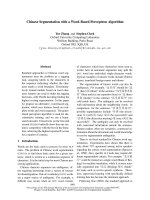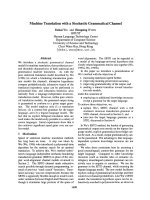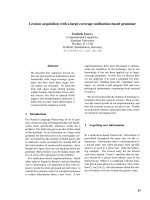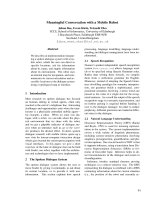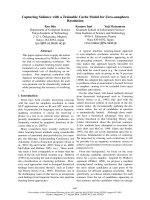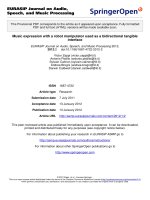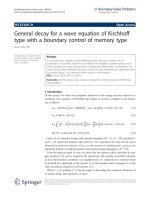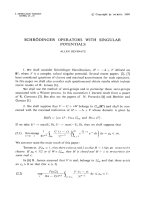Báo cáo toán học: "Set families with a forbidden subposet" pptx
Bạn đang xem bản rút gọn của tài liệu. Xem và tải ngay bản đầy đủ của tài liệu tại đây (164.55 KB, 11 trang )
Set families with a forbidden subposet
Boris Bukh
∗
Department of Pure Mathematics and Mathematical Statistics
Cambridge, CB3 0WA, UK
and
Chur chill College
Cambridge, CB3 0DS, UK
Submitted: Dec 14, 2008; Accepted: Nov 4, 2009; Published: Nov 30, 2009
Mathematics S ub ject Classification: 06A07, 05D05
Abstract
We asymptotically determine the size of the largest family F of subsets of
{1, . . . , n} not containing a given poset P if the Hasse diagram of P is a tree. This
is a qualitative generalization of several known results including Spern er’s theorem.
Introduction
We say that a poset P is a subposet of a poset P
′
if there is an injective map f : P → P
′
such that a
P
b implies f(a)
P
′
f(b). A poset P is an induced subposet of P
′
if there is
an injective map f : P → P
′
for which a
P
b if and only if f (a)
P
′
f(b). For instance,
is a subposet of , but not a n induced subposet. For a poset P a Hasse diagram, denoted
by H(P ), is a graph whose vertices are elements of P , and xy is an edge if x < y and for
no other element z of P we have x < z < y.
Let [n] = { 1 , . . . , n}, and denote by 2
[n]
the collection of a ll subsets of [n]. One can
think of a family F of subsets of [n] as a poset under inclusion. In this way F becomes an
induced subposet of the Boolean lattice. In this paper we examine the size of the larg est
family F ⊂ 2
[n]
subject to the condition that F does not contain a fixed finite subposet
P . We do not require P to be an induced subposet. A set family F not containing a
subpo set P will be called a P -free family. We denote by ex(P, n) the size of the largest
P -free family F ⊂ 2
[n]
. For example, the classical Sperner’s theorem [Spe28] asserts tha t
ex( , n) =
n
⌊n/2⌋
.
∗
This work was done while the author studied at Princeton University. Its intellectual and financial
support are g ratefully acknowledged.
the electronic journal of combinatorics 16 (2009), #R142 1
Erd˝os [Erd45] extended Sperner’s result, and proved that if C
l
denotes the chain
of length l, then ex(C
l
, n) is equal to the sum of l − 1 largest binomial coefficients
of order n. Katona and Tarj´an[KT83] proved that ex( , n) =
n
⌊n/2⌋
1 + O(1/n)
.
A common generalization of results of Erd˝os and Katona-Tarj´an was established by
Thanh[Tha98] who showed that if P
k,l
is any fixed poset with vertex set {1, . . . , k} ∪
{1
′
, . . . , l
′
} in which the relations are 1 < 2 < · · · < k and 1
′
< 1, 2
′
< 1, . . . l
′
< 1,
then ex(P
k,l
) = k
n
⌊n/2⌋
1 + O(1/n)
(the error term was subsequently improved by
de Bonis and Katona[DBK07]). For example, ex( , n) = 2
n
⌊n/2⌋
1 + O(1/n)
. In
[DBKS05] it is shown that ex( , n) =
n
⌊n/2⌋
+
n
⌊n/2⌋+1
. Griggs and Katona [GK08]
proved that ex( , n) =
n
⌊n/2⌋
1 + O(1/n)
. Recently, Griggs and Lu[GL] proved that
ex(L
4k
, n) =
n
⌊n/2⌋
1+ O(1/n)
, where L
4k
is the loop of length 4k on two adjacent levels
of the Boolean lattice.
Let Mon(Z) be the set of all functions f : Z → {0, 1} such that f(n) = 1 and f(−n) = 0
for all sufficiently large n. The elements of Mon(Z) will be called eventually monotone
functions. Fo r f, g ∈ Mon(Z) write f g if f(n) g(n) for all n. Then (Mon(Z), <) is a
distributive lattice. Note that
n
f(n) −g(n) is well-defined for every f, g ∈ Mon(Z). We
define a level of Mon(Z) to be a maximal family L ⊂ Mon(Z) satisfying
n
f(n)−g(n) = 0
for all f, g ∈ L. Note that a level of Mon(Z) is an antichain. The poset Mon(Z) can be
thought of as the induced subposet of 2
Z
spanned by the set {X ⊂ Z : |X△Y | < ∞}, for
some fixed Y ⊂ Z which is neither finite nor cofinite.
The simplest explanation for all t he results above is the following conjecture.
Conjecture. For a finite poset P let l(P ) be the maximum number of levels in Mon(Z)
so that their union does not contain P as a subposet, then
ex(P, n) = l(P )
n
⌊n/2⌋
1 + O(1/n)
.
Intuitively the conjecture asserts that the largest P -free family is essentially the union
of the maximum number of middle levels of the Boolean lattice 2
[n]
not containing P. If
true, the conjecture would b e an analogue of Erd˝os-Stone-Simonovits theorem from the
extremal graph theory which asserts that the largest graph not containing a given graph
G is essentially the largest complete partite graph not containing G
In this paper, we establish t he conjecture whenever H(P ) is a tree, generalizing several
of the results mentioned above. Unlike the papers a bove we are not concerned with
establishing the best possible bounds inside the O(1/n) term, which allows us to give a
rather short proof. The rest o f the paper is occupied by the proof of the following theorem.
Theorem 1. If P is a finite poset and H(P ) is a tree, then
ex(P, n) = (h(P ) − 1)
n
⌊n/2⌋
1 + O(1/n)
where h(P ) is the height of P , i.e., the length of the longest chain in P . Moreover,
l(P ) = h(P ) − 1 for such a P .
the electronic journal of combinatorics 16 (2009), #R142 2
For the case h(P ) = 2, the t heorem was also independently proved by Griggs and
Lu[GL] by a very different arg ument.
Proof idea
Before embarking on the proof of Theorem 1, we first non-rigorously sketch a simple
proof for the special case h(P ) = 2. The proof unfortunately does not generalize to
h(P ) 3, but it will motivate the otherwise hard-to-follow technical details of the more
general proof. We shall need a strengthening of Sperner’s lemma, to the effect that if
|F| >
n
⌊n/2⌋
, then not only there are pairs of comparable sets, but a plentitude of such
pairs. The following statement is easy and can be proved similarly to Lemma 4 below
(see [Kle68] for a sharper result for small ǫ).
Lemma 2. If |F| (1+ǫ)
n
⌊n/2⌋
, then there are at least (1/10)nǫ|F| pairs of sets F
1
⊂ F
2
contained in F.
Proof of the case h(P ) = 2 of Theorem 1 assuming Lemma 2. Suppose F ⊂ 2
[n]
is a fam-
ily of |F| (1 + 20|P |/n)
n
⌊n/2⌋
sets, where P is a poset. We will show that F contains a
copy of P . Let G be the graph with vertex set F where a pair of distinct sets F
1
, F
2
∈ F
connected by an edge if F
1
⊂ F
2
or F
2
⊂ F
1
. By Lemma 2 the average degree of G is at
least 4|P |. Since every g r aph of of average degree d contains a non-empty subgraph of
minimum degree at least d/2, the graph G contains a subgraph G
′
of minimum degree at
least 2|P |.
Then we shall embed elements of P one-by-one into V (G
′
), in such a way that at each
step embedding is injective, and preserves order. More precisely, we a ssume that P is
not a subpo set of V (G
′
), and use this assumption to construct a sequence of embeddings
π
i
: P
i
→ V (G
′
), where
a) P
i
is an induced subposet of P , and H(P
i
) is a tree,
b) P
i
\ P
i−1
consists of a single element,
c) v
P
i
u implies π
i
(v) π
i
(u) for all u, v ∈ P
i
.
First, we embed some element of P arbitrarily into V (G
′
), and let P
1
to consist of that
single element. Then, for each i 2 let v ∈ P \ P
i−1
be a not -yet-embedded element of
P , which is comparable to some u ∈ P
i−1
, and let P
i
= P
i−1
∪ {v}. Since h(P ) = 2, and
H(P ) is a tree, u is the only element of P
i−1
comparable to v. We shall define embedding
π
i
that agrees with π
i−1
on P
i−1
\ {u}.
Without loss of generality we can assume that u < v. Set τ
1
= π
i−1
, and write
u
1
= τ
1
(u). Since u
1
∈ V (G
′
), and degree of every vertex in V (G
′
) is at least 2|P| |P|+1
there is at least one neighbor u
2
of u
1
in G
′
which is not in the image of τ
1
. If u
1
< u
2
,
then we let π
i
to be an extension of τ
1
sending v to u
2
. Suppose u
1
> u
2
. Let τ
2
be
the embedding obtained from τ
1
by mapping u to u
2
instead of u
1
. The embedding τ
2
satisfies the same properties (a)–(c) that π
i−1
does. As 2|P | |P | + 2 we can again find
the electronic journal of combinatorics 16 (2009), #R142 3
a neighbor u
3
of u
2
which is neither u
1
nor in the image of π
2
, and we can assume that
u
2
> u
3
. Repeating this process |P | times yields a chain u
1
> u
2
> . . . > u
|P |
of elements
of V (G
′
). However P is a subposet (but not necessarily an induced subposet) of any linear
extension of itself, and thus embeds into {u
1
, . . . , u
|P |
} ⊂ F.
The proof above is clearly similar to the proof that every tree on d vertices embeds
into a graph of average degree 2d. To extend the pro of above to the case h(P ) = 3, for
example, it is tempting to replace the graph G by a 3-uniform hypergraph of triples of
sets in a chain. The problem with this approach is lack of any good replacement for the
concept of minimum degree. The solution is therefore to eliminate minimum degree from
the proof entirely. To see how it is done, we present an alternative way of embedding trees
in graphs of large average degree. It is far more wasteful, but avoids minimum degrees.
Proposition 3. For every tree T there is a d
0
(T ) such that T embeds into every finite
graph of average degree at least d
0
(T ).
Proof. The proof is by induction o n T , with |T| = 1 being the trivial base case. Assume
|T | 2. Let v be any leaf of T , and u be its unique neighbor. Set T
′
= T \ v. We
will show that we can take d
0
(T ) = d
0
(T
′
) + 2|T |. Suppose G is of average degree
at least d
0
(T
′
) + 2|T |. Let B = {v ∈ G : deg
G
(v) |T |}. Then the graph G
′
=
G \ B is only |B||T | edges smaller than G, and thus has has average degree at least
(d
0
(T
′
)+2|T |)−2|B||T |/|V | d
0
(T
′
). By the induction hypothesis there is an embedding
π : T
′
→ G
′
. As π(u) ∈ G
′
, we infer deg
G
(π(u)) > |T | , implying that there is at least one
neighbor of π(u) that is not in π(T
′
). Use this neighbor to extend the embedding π of T
′
to an embedding of T
′
∪ {v} = T .
For technical reasons, it turns out to be easier to work with marked chains rather than
hypergraphs; intuitively this change corresponds to hypergraphs with weighted edges. In
the o ther respects, the proof of Theorem 1 is a straightforward generalization of the two
arguments above.
Proof of Theorem 1
By an interval in a poset P we mean a set of the form [x, y] = {z ∈ P : x z y}.
A maximal chain in a poset P is a chain, which is not contained in any other chain. In
particular, a maximal chain in 2
[n]
is a chain of sets ∅ = S
0
⊂ S
1
⊂ · · · ⊂ S
n
= [n] with
|S
i
| = i. A k-marked chain with markers F
1
, . . . , F
k
is a k + 1-tuple (M, F
1
, . . . , F
k
) where
M is a maximal chain in 2
[n]
, F
1
⊃ · · · ⊃ F
k
and F
1
, . . . , F
k
belong to M.
Lemma 4. If F ⊂ 2
[n]
is of size
|F| (k − 1 + ǫ)
n
⌊n/2⌋
,
then there are at least (ǫ/k)n! k-marked chains whose markers belong to F.
the electronic journal of combinatorics 16 (2009), #R142 4
Proof. Let C
i
be the number of maximal chains tha t contain exactly i sets from F.
Counting the number of pairs (F, M) where F ∈ F is an element of a maximal chain M
in two different ways, we obtain
i
iC
i
=
F ∈F
n!
n
|F |
|F|
n!
n
⌊n/2⌋
(k − 1 + ǫ)n!.
From this and
C
i
= n!, we infer that
ik
iC
i
i
iC
i
− (k − 1)
ik−1
C
i
ǫn!.
The number of k-marked chains with markers in F is
ik
i
k
C
i
=
ik
i − 1
k − 1
i
k
C
i
1
k
ik
iC
i
ǫ
k
n!.
Call a poset P of height k saturated if every maximal chain is of length k. For us
the maximal chains in P play the role analog ous to the edges of a tree T in Proposi-
tion 3. However, in general the edges might have different sizes, which is analogous to
dealing with non-uniform hypergraphs. The saturated posets are the analogues o f uniform
hypergraphs.
The next two lemmas establish a couple of intuitively obvious, but annoyingly hard
to rigorously prove facts abo ut saturated posets whose Hasse diagram is a tree. The first
lemma will be used to reduce the problem of embedding an arbitrary P to the problem
of embedding saturated P . The second lemma will allow us to do induction on |P |.
Lemma 5. If P is a finite poset with H(P ) being a tree, then P is an induced subposet
of some saturated finite poset
˜
P with H(
˜
P ) being a tree, and h(P ) = h(
˜
P ).
Proof. For the purpose of this proof let s(P ) be the number of maximal chains in P .
Since every element is contained in some maximal chain, |P | s(P )h(P ), implying that
for fixed s and k there only finitely many posets P with s(P ) = s and h(P ) = k. Assume
there is a counterexample to the lemma. Let P be a counterexample with the largest
number of elements for given s(P ) and h(P ).
Since P is not saturated there is a maximal chain v
1
< · · · < v
t
in P of length t < k.
For each i = 0, . . . , t −1 we can define a new poset P
i
which is obtained from P by adding
a new element v and two new relations v
i
< v and v < v
i+1
(in the case i = 0 we add
only one new relation). Clearly, s(P
i
) = s(P ) and P is an induced subposet of P
i
. We
will show by induction on i that for each i = 0, . . . , t − 1 either h(P
j
) = h(P ) for some
j i, or there is a chain in P of length k − i whose smallest element is v
i+1
.
If h(P
0
) > k, then there is a chain C in P
0
of length k + 1. Since C is not a chain of P ,
it contains v. Thus v
1
∈ C, and C \ {v} contains v
1
and has length k. Now suppose i 1
and we have established the inductive claim for all smaller values of i. If h(P
j
) > h(P )
for all j = 0, . . . , i − 1, then by the induction hypothesis there is a chain C ⊂ P of length
the electronic journal of combinatorics 16 (2009), #R142 5
k − i + 1 whose smallest element is v
i
. Therefore, all chains in P whose largest element
is v
i
have lengths not exceeding i. Since the length of the chain v
1
< · · · < v
i
is i, the
assumption h(P
i
) > k implies that there is a chain in P of length at least k − i whose
smallest element is v
i+1
. This establishes the inductive claim.
Hence, if h(P
i
) > h(P ) for all i, there is a chain o f length k − t + 1 2 whose
smallest element is v
t
. This contradicts the maximality of v
1
< · · · < v
t
, implying that
h(P
i
) = h(P ) for some i. However, P was assumed to be the largest counterexample with
given s(P ) and h(P ). Therefore, there are no counterexamples to the lemma.
Lemma 6. Suppose P is a saturated finite poset of height h(P) = k 2, and H(P ) is a
tree. Furthermore, assume that P is not a chain. Then there is a v ∈ P , which is a leaf
in H(P ), and an interval I of length |I| k − 1 containing v such that H(P \ I) is a tree,
and the poset P \ I is a saturated poset of height h(P ).
Proof. A sequence v
1
, . . . , v
l
∈ P is said to be a poset path of length l − 1 if v
i
and v
i+1
are comparable for all i. A poset distance between v and u, denoted pdist(v, u), is the
shortest length of a poset path connecting them.
u
v
I
Let v and u be a pair of leaves maximizing pdist(v, u), and let
v = v
1
, v
2
, v
3
, . . . , v
l
= u be the shortest poset path between them.
Observe that pdist(v, u) 2, for P is not a chain. Without loss
of generality we can assume that v < v
2
, for we can consider the
opposite poset otherwise. Let I
0
be the longest interval containing
v, all of whose elements have degree at most two in H(P ). If |I
0
| <
h(P ), set I = I
0
. If |I
0
| = h(P ), set I = I
0
\ {max I
0
}, where max I
0
is the largest element of I
0
.
Let C be an arbitrary maximal chain in P \ I. We will show that C has length h(P ).
Suppose C contains an element w which is incomparable with I. Let then M be a maximal
chain in P containing C. Since w is comparable to every element of M, the chain M is
disjoint from I, implying C = M and h(C) = h(M) = h(P ). So we can suppose that all
elements of C are comparable to I.
If |I
0
| = h(P ), then the only element in P \ I which is comparable to I is max I
0
.
Since P is not a chain, there is a chain of length two containing max I
0
, which is disjoint
from I, contradicting the maximality of C. Hence, we can assume that |I
0
| < h(P ). Let
w be any element of P \ I comparable to an element z of I. If w < z, then min([w, z] ∩ I)
has degree at least 3 in H(P ). If z < w and max I < w, then max([z, w] ∩ I) has degree
at least 3 in H(P ). In either case, we reach a contradiction with the choice of I. Hence
w exceeds all elements of I. Taking w = min C, it follows that max I < min C. By the
maximality of C, there is no z ∈ P \I satisfying max I < z < min C. Upon taking w = v
2
,
it also follows that max I < v
2
, implying min C v
2
. If v
2
= min C, then C ∪ {v
3
} is also
a chain, contradicting the maximality of C. Let y = max C. The only path from u to y
in H(P ) goes through v
2
and min C. Therefore every poset path from u to y has to go
through v
2
and min C, implying pdist(y, u) > pdist(v, u). Though the element y needs
not to be a leaf itself, if z is any leaf of H(P ) such that the path from u to z goes through
y, then pdist(z, u) pdist(y, u) > pdist(v, u), contradicting the choice of v and u.
the electronic journal of combinatorics 16 (2009), #R142 6
The core of the proof of Theorem 1 is contained in the following lemma. In the lemma
the family of k-marked chains L plays analo gous role to the graph G in the Proposition 3,
with F being analogous to the vertex set of G. The condition that F does not contain
a chain of length K comes f rom the fact that every poset embeds into every sufficiently
long chain.
Lemma 7. Let P be a saturated finite poset of height h(P ) = k 2, whose Hasse diagram
is a tree. Suppose F ⊂ 2
[n]
is a set family, such that no chain contains more than K sets
from F, and all sets in F are of size between n/4 and 3n/4. Moreover, suppose L is a
family of k-marked chains with markers in F of size
|L|
|P |+1
2
4
K+1
n
n!.
Then there is an embedding of P into F in which every maximal chain of P is mapped to
the set of markers of some k-marked chain in L.
Proof. The proof is by induction on |P |. If P is the chain of length k, then finding the
required embedding is easy: marked elements on any L ∈ L form the desired chain. Now
suppo se we want to embed P , and have already established the lemma for all smaller
saturated posets. Use the preceding lemma to obtain a leaf v and an interval I ∋ v such
that P \ I is a still a saturated poset of height k. By passing to the opposite poset to P
and replacing F by
¯
F = {[n] \ F : F ∈ F} if necessary, we can assume that v is smaller
than any element that is comparable with v. Let C be a maximal chain containing I. Let
s = |C \ I| = k − |I|. Note that s 1.
Call a chain F
1
⊃ · · · ⊃ F
s
of length s a bottleneck if there is a set S ⊂ F with than |P |
elements such that for every k-marked chain in L of the form (M, F
1
, . . . , F
s
, F
s+1
, . . . , F
k
)
we have S ∩ {F
s+1
, . . . , F
k
} = ∅. Such an S is said to be a witness to the fact that
F
1
⊃ · · · ⊃ F
s
is a bottleneck. Note that without loss of generality, a witness contains
only proper subsets of F
s
. For each bottleneck F
1
⊃ · · · ⊃ F
s
, let S(F
1
, . . . , F
s
) be a fixed
witness containing only proper subsets of F
s
. Call a k-marked chain (M, F
1
, . . . , F
k
) ∈ L
bad if for some s the chain F
1
⊃ · · · ⊃ F
s
is a bottleneck.
Consider any s-element set R = {r
1
, . . . , r
s
} of integers with 1 r
1
< · · · < r
s
K. If
M is a maximal chain in 2
[n]
containing at least r
s
elements from F, let F
1
⊃ F
2
⊃ · · · ⊃
F
r
s
be the r
s
largest of these elements. The subchain of F
1
⊃ F
2
⊃ · · · ⊃ F
r
s
indexed by
R is F
r
1
⊃ F
r
2
⊃ · · · ⊃ F
r
s
, and we denote it by C
R
(M). If C
R
(M) is a bottleneck, and L
contains a k-marked chain of t he form (M, . . . ), whose s largest markers are C
R
(M), then
we say that M is R-bad. Intuitively, the R-bad chains correspond to the edges adjacent
to the vertices of low degree in Proposition 3.
Pick a maximal chain M in 2
[n]
uniformly at random. Let B
R
be the event that M is
R-bad. We will estimate Pr[B
R
] for each fixed R individually.
One way to pick a random maximal chain M of 2
[n]
is to start with [n] and remove
elements one by one, each step choosing an element uniformly at random among the
remaining elements. Thus one can generate chain M in two stages. In the first stage, we
remove elements from [n] at random until either we encounter r
s
sets from F, or until we
the electronic journal of combinatorics 16 (2009), #R142 7
run out of elements to remove. Denote by T the chain obtained at the end of the first
stage (it is not a maximal chain, unless we ran out of elements). In the second stage, we
resume removing elements at random from min T, until no elements are left. If T is not
maximal, then C
R
(M) is independent of what happens in the second stage, and C
R
(T ) is
defined in the obvious way.
If T is a maximal chain, or C
R
(T ) is not a bottleneck, then B
R
does not hold. Other-
wise, let S = S(C
R
(T )) be the witness that C
R
(T ) is a bottleneck. Recall that S ⊂ F,
|S| < |P | and S meets every k-chain in L whose top s markers are C
R
(T ). Let
T
R
= {chain T
0
in 2
[n]
: |T
0
∩ F| = r
s
, C
R
(T
0
) is a bottleneck}.
The probability that M meets S is thus
Pr[M ∩ S = ∅ | C
R
(T ) is a bottleneck] max
T
0
∈T
R
Pr[M ∩ S = ∅|T = T
0
]
max
T
0
∈T
R
|S(C
R
(T
0
))| max
F ∈F
F <min T
0
Pr[F ∈ M|T = T
0
]
|P | max
T
0
∈T
R
max
F ∈F
F <min T
0
Pr[F ∈ M|T = T
0
]
|P | max
T ∈T
R
max
F ∈F
F <min T
0
1
|F | + 1
|P | max
F ∈F
1
|F | + 1
,
4|P |/n
where the fourth inequality f ollows because at the step before obtaining F , we have |F |+1
choices as to which element to remove, with at most one choice yielding F . If M ∩ S = ∅,
then there is no k-marked chain of the form (M, . . . ) in L, and B
R
does not hold. Therefore
Pr[B
R
] = Pr[C
R
(T ) is a bottleneck] Pr[B
R
|C
R
(T ) is a bottleneck]
Pr[C
R
(T ) is a bottleneck] Pr[M ∩ S = ∅ | C
R
(T ) is a bottleneck] 4|P |/n.
Since R is a subset of [K], the number of pairs (M, R) where M is an R-bad maximal chain
is at most (4|P |
K
s
/n)n!. Since no chain contains more than K elements of F, every bad k-
marked chain gives rise to one such pair (M, R). Since R ⊂ [K], every pair (M, R) arises in
at most
K
s
ways, implying that there are no more than (4|P |
K
s
2
/n)n! (|P |4
K+1
/n)n!
bad k-marked chains in L.
Let L
′
be the set of all good k-marked chains in L. There are
|L
′
| |L| −
|P |4
K+1
n
n!
4
K+1
|P |+1
2
− |P |
n
n! =
|P |
2
4
K+1
n
n!
of them. By the induction hypothesis there is an embedding π : P \ I → F. Recall
that C was a maximal chain containing I, and look at C \ I. Since P \ I is saturated,
the electronic journal of combinatorics 16 (2009), #R142 8
C \ I is contained in some chain C
′
of length k in P \ I. Therefore π(C
′
) is contained in
some L ∈ L
′
. Since all k-marked chains in L
′
are good, π(C \ I) is not a bottleneck. In
particular, since | P \ I| < |P |, we infer that π(P \ I) is not a witness that π(C \ I) is a
bottleneck. Thus there is a k-marked chain
˜
L ∈ L containing π(C \ I) a s markers, but
not containing any other element of π(P \ I) as a marker. Therefore, we can map I to
the bottom k − s markers of
˜
L, completing the desired embedding.
With most of the work already done, we are ready to prove our main result.
Proof of Theorem 1. If h(P ) = 1, then P is a single-element poset, and the theorem is
trivially true. So, assume that h(P ) 2. Consider the case when P is a saturated poset,
and suppose
|F| (h(P ) − 1)
n
⌊n/2⌋
1 +
h(P )|P |
2
4
|P |+2
n
and n is sufficiently large. We will show tha t F contains P . The number of sets F ∈ 2
[n]
with fewer than n/4 or more than 3n/4 elements is equal 2
n
times the probability t hat
for a randomly chosen F ∈ 2
[n]
we have ||F | − n/2| > n/4. Thus by Chernoff’s inequality
the number of such sets F ∈ 2
[n]
is at most 2
n
· 2 exp
−2(n/4)
2
/n
= o
n
⌊n/2⌋
/n
. Let
F
′
= {F ∈ F : |F − n/2| n/4}. As our n is sufficiently large,
|F
′
| (h(P ) − 1)
n
⌊n/2⌋
1 +
h(P )|P |
2
4
|P |+1
n
.
Therefore, from Lemma 4 and Lemma 7 applied with k = h(P ) and K = |P | it follows
that either there is an embedding of P into F
′
or F
′
contains a chain C of length |P |.
In the latter case, we can find an embedding π of P into F
′
anyway by simply letting
π : P → C be any linear extension of P .
If H(P ) is a tr ee and P is not a saturated poset, then by Lemma 5 it is contained in
some saturated poset P
′
of height h(P
′
) = h(P ), such that H(P
′
) is a tree. Therefore
ex(P, n) = (h(P ) − 1)
n
⌊n/2⌋
(1 + O(1/n)) for every poset P , for which H(P ) is a tree.
It remains to prove that l(P ) = h(P ) − 1. The inequality l(P ) h(P) − 1 is clear,
as a union of h(P ) − 1 levels does not contain a chain of length exceeding h(P ) − 1, and
hence does not contain P . Let L
1
, . . . , L
h
be h distinct levels of Mon(Z), and let L be
their union. Suppose furthermore that the levels L
i
are so ordered that for any functions
f
i
∈ L
i
, the inequality
n
f
i
(n) − f
j
(n) > 0 holds whenever i > j (by the definition of
a level, if the inequality holds between a pair functions in levels L
i
and L
j
, then it holds
for all pairs).
To complete the proof, we need to exhibit an embedding of P into L. By Lemma 5
it suffices to treat the case when P is saturated. We will prove the existence of the
embedding by induction on |P |. If P is a chain of length h, then the embedding is
obvious. Suppose P is not a chain, we can find embedding for all smaller saturated P
of height h. By Lemma 6 there is a leaf v and an interval I of the form I = [v, u) such
that P \ I is a saturated poset of height h. By induction P \ I is embeddable into L.
Fix any such embedding. Since π(u) is contained in a chain of length k in L, and P is
the electronic journal of combinatorics 16 (2009), #R142 9
saturated, it follows that π(u) ∈ L
|I|+1
. Let n
0
be a large enough that (π(w))(n) = 1 for
all w ∈ P \ I and n n
0
. Complete the embedding by mapping the interval I to the
interval of functions f
1
, . . . , f
|I|
∈ Mon(Z) defined by
f
i
(n) =
0, if n
0
n n
0
+ i − 1,
(π(w))(n), otherwise.
Concluding remarks
Though it would be interesting to determine exactly or find very good asymptotic esti-
mates for ex(P , n) in general, a first step is to find the leading term in the asymptotic.
In this paper we found the leading term of ex(P, n) whenever H(P ) is a tree. For some
posets P whose Hasse diagram is not a tree, one can find a poset P
′
that contains P and
whose Hasse diagram is a tree with l(P ) = l(P
′
), to obtain that ex(P, n) ∼ ex(P
′
, n).
For example, ex( , n) ∼ ex( , n), and similarly for other complete two-level posets, thus
recovering the results from [DBK07, Section 5]. The simplest two posets that are not
subpo sets of trees with the same value of l(P ) are and , and the asymptotics of the
function ex for these posets is not known.
It is conceivable that the conjecture in this paper is even true if its premise that F
does not contain a subposet P is replaced by the weaker premise that F does not contain
P as an induced subposet.
Acknowledgement. I thank M´at´e Matolcsi for reading a preliminary version of
this paper, and two referees for useful suggestions.
References
[DBK07] Annalisa De Bonis and Gyula O. H. Ka tona. Largest families without an
r-fork. Order, 24(3):181–191, 2007.
[DBKS05] Annalisa De Bonis, Gyula O. H. Katona, and Konrad J. Swanepoel. Largest
family without A ∪ B ⊆ C ∩ D. J. Combin. Theory Ser. A, 111(2):331–336,
2005. arXiv:math/0407373v1.
[Erd45] P. Erd¨os. On a lemma of Littlewood and Offord. Bull. Amer. Math. Soc.,
51:898–902, 1945 .
[GK08] Jerrold R. Griggs and Gyula O. H. Katona. No four subsets
forming an N. J. Combin. Theory Ser. A, 115(4):677–685, 2008.
/>∼
IMI/technical/07papers/0704.pdf.
[GL] Jerrold R. Griggs and Linyuan Lu. On families of subsets with a forbidden
subpo set. arXiv:0807.3702v1.
[Kle68] D. Kleitman. A conjecture of Erd˝os-Ka t ona on commensurable pairs among
subsets of an n-set. In Theory of Graphs (Proc. Colloq., Tihany, 1966), pages
215–218. Academic Press, New York, 1968.
the electronic journal of combinatorics 16 (2009), #R142 10
[KT83] G. O. H. Katona and T. G. Tarj´an. Extremal problems with excluded sub-
graphs in the n-cube. In Graph theory (Lag´ow, 1981), volume 1018 of Lecture
Notes in Math., pages 84–93. Springer, Berlin, 1983.
[Spe28] Emanuel Sperner. Ein Satz ¨uber Untermengen einer endlichen Menge. Math.
Z., 27(1):544–548, 1928.
[Tha98] Hai Tran Thanh. An extremal problem with excluded subposet in the Boolean
lattice. Order, 15(1):51–57, 1998.
the electronic journal of combinatorics 16 (2009), #R142 11
